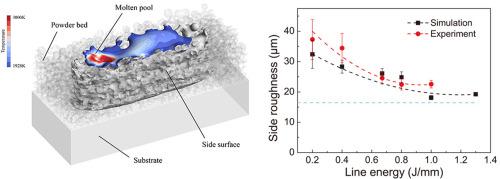Additive Manufacturing ( IF 10.3 ) Pub Date : 2021-08-30 , DOI: 10.1016/j.addma.2021.102274 Chaochao Wu 1 , Muhammad Qasim Zafar 1 , Haiyan Zhao 1, 2 , You Wang 3 , Christoph Schöler 3 , Christian Heinigk 3 , Markus Nießen 4 , Wolfgang Schulz 3, 4

|
Surface roughness is a serious concern in powder bed fusion (PBF) additive manufacturing, especially for aerospace and biomedical applications. An adequate surface quality of as-built components is desired due to difficulty in post-processing of interior sides and intricate geometries of printings. The side surface draws more attention than the top surface and a comprehensive understanding of side roughness mechanisms is required to interpret effectively. However, observation of side roughness formation in experiments is yet difficult. In this paper, the formation process of the side surfaces in electron beam PBF is analyzed by a 3-D mesoscale multi-physics simulation, so as to provide an insight view into side roughness mechanisms from the viewpoint of heat and mass transfer. The melting process and the resulting side surface morphologies of thin-walled parts are exclusively analyzed. It turns out that the melted traces in cases with a relatively low heat input generally have greater fluctuations than in cases with a high heat input, which leads to a higher side roughness. The proposed investigation reveals that the melt pool flow driven by surface tension is the main cause of track shape fluctuation. This fluctuation is driven by the random distribution of powder particles and the Plateau–Rayleigh instability, which describes the disintegration into a chain of drops. An analytical estimation of minimum limit of side roughness in as-built parts and the mechanisms for the generation of the side roughness are depicted systematically, based on which some improvement measures are proposed finally. This will help improve surface quality in metal additive manufacturing.
中文翻译:

粉末床熔合中侧面粗糙度产生机制的多物理场建模
表面粗糙度是粉末床融合 (PBF) 增材制造中的一个严重问题,尤其是对于航空航天和生物医学应用。由于内侧的后处理困难和印刷的复杂几何形状,因此需要足够的完工部件表面质量。侧面比顶面更受关注,需要全面了解侧面粗糙度机制才能有效解释。然而,在实验中观察侧面粗糙度的形成仍然很困难。在本文中,通过 3-D 中尺度多物理场模拟分析了电子束 PBF 侧表面的形成过程,以便从传热和传质的角度深入了解侧部粗糙度机制。专门分析了薄壁零件的熔化过程和由此产生的侧表面形态。事实证明,在热输入相对较低的情况下,熔化的痕迹通常比在热输入高的情况下具有更大的波动,这会导致更高的侧面粗糙度。拟议的调查表明,由表面张力驱动的熔池流动是轨道形状波动的主要原因。这种波动是由粉末颗粒的随机分布和高原-瑞利不稳定性驱动的,它描述了分解成液滴链。系统地描述了竣工件侧面粗糙度最小极限的解析估算和侧面粗糙度的产生机理,并在此基础上提出了一些改进措施。











































 京公网安备 11010802027423号
京公网安备 11010802027423号